‘The Hokuleʻa is home’

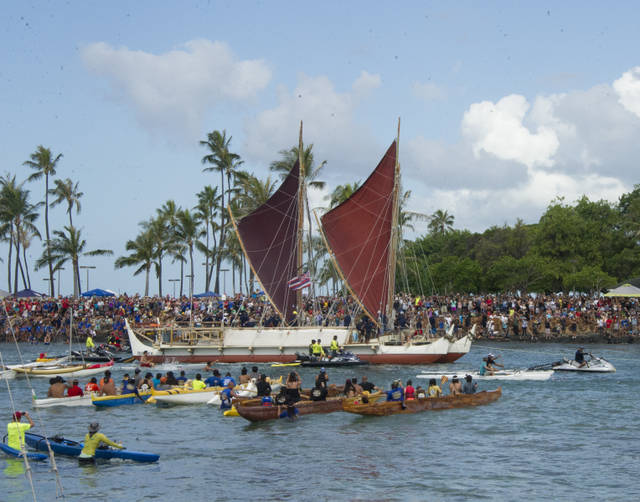
CRAIG T. KOJIMA / CKOJIMA@STARADVERTISER.COM
Hokule‘a arrived today to the thrill of thousands at Magic Island.
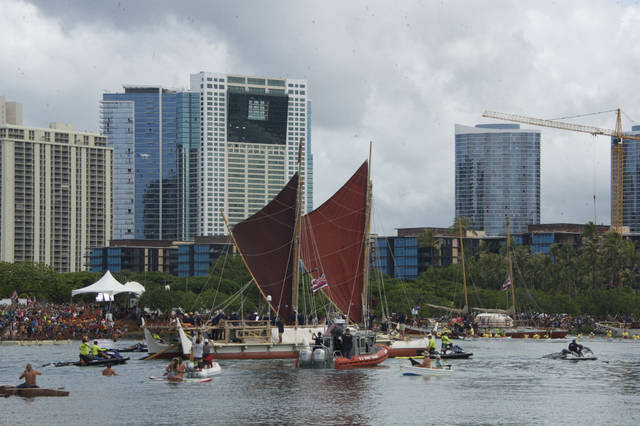
CRAIG T. KOJIMA / CKOJIMA@STARADVERTISER.COM
Canoes followed Hokule‘a into Ala Wai Harbor.
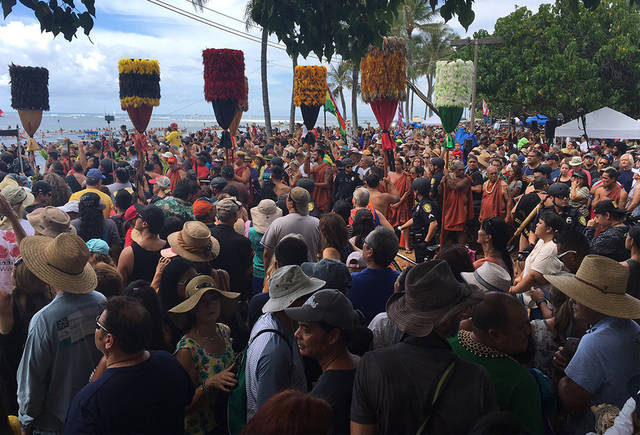
MARCEL HONORE / MHONORE@STARADVERTISER.COM
Kahili bearers gathered at Magic Island for the arrival of Hokuleʻa.
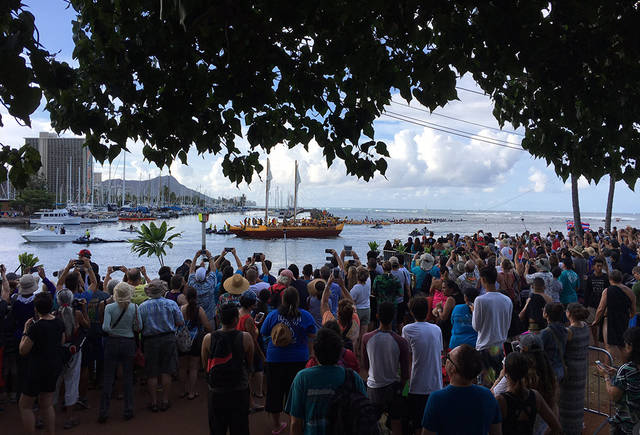
MARCEL HONORE / MHONORE@STARADVERTISER.COM
Kauai sailing canoe Namahoe arrived first in the Hokule‘a procession at Magic Island today.
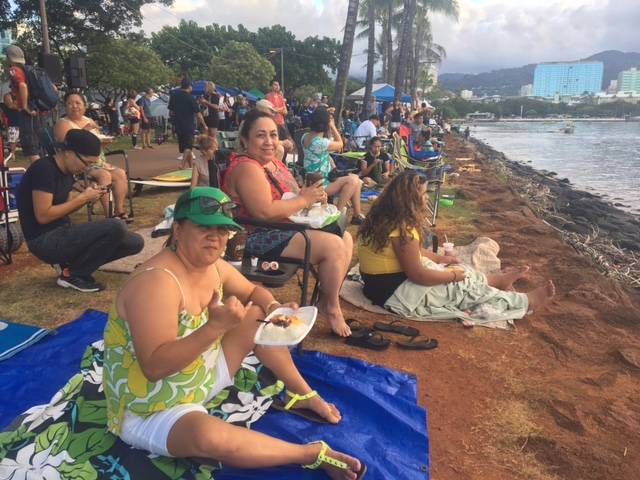
CRAIG T. KOJIMA / CKOJIMA@STARADVERTISER.COM
Crowds await the arrival of Hokule‘a at Magic Island today.






1:05 p.m.
In a passionate, emotional speech, Polynesian Voyaging Society president Nainoa Thompson remembered the people who were instrumental in the history of the Hokule’a while stressing the importance of passing down the lessons and skills learned from the voyaging canoe to the next generations.
He remembered and honored the inspiration of his father Myron “Pinky” Thompson, legendary crewmember Eddie Aikau, astronaut Charles Lacy Veach, navigator Mau Piailug and anthropologist Ben Finney, among many others.
>> Photo gallery: Hokule‘a’s homecoming
>> Hokule‘a’s voyage aims to rally support around the globe
Near the end of his remarks, the lei-bedecked Thompson, who is a pwo (master) navigator, said, “I’m very humbled and very proud to tell you that the Hokule’a is home.”
12:20 p.m.
Don't miss out on what's happening!
Stay in touch with breaking news, as it happens, conveniently in your email inbox. It's FREE!
Gov. David Ige welcomed the Hokule’a and its crew back during the homecoming ceremony by saying, “Watching you on your epic voyage, you taught us that there is more than connects the world than divides us.”
Ige spoke of how the voyage had inspired the sustainability movement and received a standing ovation when he reminded the crowd that last week Hawaii became the first state to commit to the Paris Climate Agreement.
Ige was followed by Mayor Kirk Caldwell who presented Nainoa Thompson with a ceremonial key to the city. “Watching the canoe come in, I think many of us had tears in our eyes,” the mayor said.
10:15 a.m.
Nainoa Thompson leads the crew off the canoe and onto Magic Island for the formal homecoming ceremony, which is scheduled to last for about two hours and include welcoming remarks from Gov. David Ige and Mayor Kirk Caldwell and a short speech by Thompson. After a lunch break, various Hawaiian musicians will perform at a ho’olaule’a from 1 p.m. to 5:30 p.m.
10 a.m. update
The Hokule’a docks at Magic Island and the crew — led by pwo (master) navigator and Polynesian Voyaging Society president Nainoa Thompson — bow their heads in prayer before disembarking.
9:40 a.m. update
To the thrill of thousands on Magic Island, the Hawaii voyaging canoe enters Ala Wai Boat Harbor as it formally ends it three-year, worldwide “Malama Honua” (Care for Island Earth) voyage. The arrival is the culmination of a 40,000 nautical miles journey that spanned three oceans, using traditional wayfinding navigation to visit 19 countries.
9:25 a.m. update
Hikianalia, which was launched in 2012 and accompanied the Hokule’a in the Pacific for the first legs of the global voyage, has arrived at Magic Island. The Hokule’a, accompanied by an armada of smaller canoes and boats, is just offshore of the Ala Wai Boat Harbor and visible to the growing crowd of thousands at Magic Island.
9:10 a.m. update
The Tahiti-based voyaging canoe Fa’afaite was the next to arrive to Magic Island. It is the same model canoe as the Hikianalia, which escorted the Hokule’a during the early stages of its worldwide voyage. The Hikianalia is expected to be the next to arrive, and the Hokule’a is heading toward Magic Island for its formal return to Hawaii after its three-year global voyage.
8:45 a.m. update
Both entrances to Ala Moana Beach Park are now closed to traffic. Okeanos of the Marshall Islands has arrived. The canoe sailed from Tahiti.
8:25 a.m. update
The next voyaging canoe to arrive at Magic Island ahead of the Hokule’a was the Makali’i from Hawaii island, led by pwo (master) navigator Chadd Onohi Paishon and Pomai Bertelmann, who captained the Hokule’a home. The Makali’i was launched in 1995 in Kawaihae and was recently in drydock. The Makali’i was followed by another Hawaii island canoe, the Hawai’iloa.
The crowd at Magic Island and Ala Moana Beach Park continues to grow as the Hokule’a remains just offshore.
7:50 a.m. update
Under sunny skies and before a crowd of the thousands, the official welcoming ceremony of the canoe Hokuleʻa is underway at Magic Island. The first canoe to arrive in the procession ahead of the Hokule’a was the Kauai sailing canoe Namahoe, the youngest of Hawaii fleet, which made its Oahu debut. The Namahoe was followed by the Mo’okiha O Pi’ilani from Maui.
Previous coverage from Associated Press
No modern navigation instrumentation guided a Polynesian voyaging canoe as it followed the horizon during a three-year journey around the globe.
About a dozen crewmembers for each leg of the voyage relied only on their understanding of nature’s cues — ocean swells, stars, wind, birds— and their own naau, or gut, to sail across about 40,000 nautical miles to 19 countries, spreading a message of malama honua: Caring for the earth.
Thousands are expected today at Magic Island to welcome double-hulled canoe Hokuleʻa home.
“Watching Hokuleʻa crest the waves of Oahu’s south shore as she returns home, much like the canoes of our ancestors, will be a once in a lifetime experience,” said Nainoa Thompson, navigator and president of the Polynesian Voyaging Society who oversaw the expedition and mission.
The voyage is perpetuating the traditional wayfinding that brought the first Polynesians several thousand miles to Hawaii hundreds of years ago. The trip also helped train a new generation of young navigators.
RELATED
>> Bus, bikes, shuttles for those greeting Hokule‘a
>> Salt celebrates Hokule‘a with night market
>> Hokule‘a’s lessons spread far, wide
>> Hokule‘a, ka waʻa kaʻapuni honua
Hokuleʻa means star of gladness. The canoe was built and launched in the 1970s, when there were no Polynesian navigators left. So the Voyaging Society looked beyond Polynesia to find one.
Mau Piailug, from a small island called Satawal in Micronesia, was among the last half-dozen people in the world to practice the art of traditional navigation and agreed to guide Hokuleʻa to Tahiti in 1976.
“Without him, our voyaging would never have taken place,” the Polynesian Voyaging Society said on the website for Hokuleʻa. “Mau was the only traditional navigator who was willing and able to reach beyond his culture to ours.”
The epic round-the-world voyage that started in 2014 shows how far Hokuleʻa has gone since its first voyage from Hawaii to Tahiti in 1976.
Disaster befell another voyage in 1978 when the canoe capsized off the Hawaiian island of Molokai in a blinding storm. Eddie Aikau, a revered Hawaiian surfer and lifeguard on the crew, grabbed his surfboard and paddled for help, but was never seen again. The rest of the crewmembers were rescued.
Crewmembers hope the success of the latest journey will inspire other indigenous cultures to rediscover and revive traditions. Thompson said he also hopes indigenous cultures can help with solutions to modern-day problems such as climate change.
* View the special section: The Homecoming
—
>> Leg 1: Crew departs Hilo heading toward new experiences, unfamiliar waters
>> Leg 2: After Australia visit, crew member gets into trouble during rough seas
>> Leg 3: Treacherous trip to South Africa ends with connection to early civilization
>> Leg 4: After sailing to Brazil, the crew makes noteworthy visit to Cuba
>> Leg 5: East Coast segment honors multiple Native American tribes
>> Leg 6: Budding crew leaders take the helm as they head home
>> Journey tests Hokuleʻa crews’ strengths, but also offers liberation
>> Hokuleʻa’s future plans include visits to 30 ports across state
>> Apprentices hone skills under master navigators’ guidance
>> Hokuleʻa crews spread message via video chats, email and tours
Native Hawaiian ancestors were not only skilled navigators but good stewards of the islands who farmed and fished sustainably.
“They figured it out — how to live well on these islands,” Thompson said. “And I think that is the challenge of the time for planet earth and all of humanity.”
Crewmembers of the worldwide voyage were mindful to incorporate that into daily life.
Fish they caught for meals never went to waste, even when the crew once landed a 49-pound ahi, crewmember Naalehu Anthony, who participated in about half-a-dozen legs of the voyage, recalled in a blog post.
“The fish was plenty for us for the day,” he wrote. “In fact too much — because we do not have any refrigeration, we either need to consume it, share it or dry it.”
Crewmembers slept in plywood bunks covered with waterproof canvas and bathing was simple, recalled Russell Amimoto, a Hōkūleʻa crewmember for two legs.
“We have unlimited supply of nice, ocean-temperature saltwater available,” he said, explaining that crewmembers threw a bucket attached to a rope overboard to scoop up water for bathing.
“We’ll towel-off right away to try to get as much salt off us as possible,” Amimoto said.
The voyage has had challenges and reaching South Africa in 2015 — the journey’s halfway point — was the most dangerous leg because of complicated ocean conditions.
In February, a team of four apprentice navigators spotted tiny, remote Easter Island. Pinpointing the island that is also known as Rapa Nui at sunset was a major accomplishment because it is considered one of the most difficult islands to find using traditional wayfinding.
During the Caribbean leg of the trip last year, Hokuleʻa stopped in Cuba, where crewmembers joined a meeting on U.S.-Cuba relations and discussions on cultural connections between Cuba and Hawaii.
Last week the crew spotted the 10,023-foot peak of Haleakala looming in the distance, signifying Hokuleʻa’s official return to Hawaii waters.
After returning, Hokuleʻa will embark on an eight-month trip sailing throughout the Hawaiian islands.
“We will go to as many as 70 communities and 100 schools to thank Hawaii’s people and share what we have learned with their children,” Thompson said. “We are also looking forward to hearing Hawaii stories of malama honua.”
Click here to look back on Hōkūleʻa’s worldwide journey. Opens in a new tab



